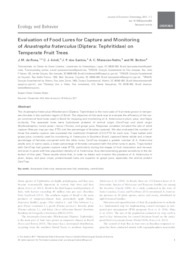Evaluation of food lures for capture and monitoring of anastrepha fraterculus (Diptera: Tephritidae) on temperate fruit trees.
Evaluation of food lures for capture and monitoring of anastrepha fraterculus (Diptera: Tephritidae) on temperate fruit trees.
Autoria: ROSA, J. M. da; ARIOLI, C. J.; SANTOS, J. P. dos; MENEZES-NETTO, A. C.; BOTTON, M.
Resumo: The Anastrepha fraterculus (Wiedemann) (Diptera: Tephritidae) is the main pest of fruit trees grown in temperate climates in the southern region of Brazil. The objective of this work was to evaluate the efficiency of the major commercial food lures used in Brazil for trapping and monitoring of A. fraterculus in plum, pear, and feijoa orchards. The assessed lures were hydrolyzed proteins of animal origin (CeraTrap) and plant origin (BioAnastrepha), torula yeast þ borax (Torula), and grape juice. Response variables included the rate of adult capture (flies per trap per day, FTD) and the percentage of females captured. We also evaluated the number of times the weekly capture rate exceeded the traditional threshold of 0.5 FTD for each lure. Traps baited with grape juice, currently used for monitoring A . fraterculus in Southern Brazil, captured fewer adults and a lower percentage of females compared with the other lures. CeraTrap trapped a greater number of A . fraterculus adults and, in some cases, a lower percentage of females compared with the other lures in pears. Traps baited with CeraTrap had greater capture rates (FTD), particularly during the stages of fruit maturation and harvest, and even in years with low population density of A. fraterculus , thus demonstrating greater sensitivity in the detection of this pest. These results show that, in order to detect and monitor the presence of A . fraterculus in plum, feijoa, and pear crops, protein-based lures are superior to grape juice, especially the animal protein CeraTrap.
Ano de publicação: 2017
Tipo de publicação: Artigo de periódico
Unidade: Embrapa Uva e Vinho
Palavras-chave: Anastrepha Fraterculus, Control index, Doença de planta, Monitoring (pests), Praga, Temperate-zone fruit
Observações
1 - Por padrão são exibidas publicações dos últimos 20 anos. Para encontrar publicações mais antigas, configure o filtro ano de publicação, colocando o ano a partir do qual você deseja encontrar publicações. O filtro está na coluna da esquerda na busca acima.
2 - Para ler algumas publicações da Embrapa (apenas as que estão em formato ePub), é necessário ter, no celular ou computador, um desses softwares gratuitos. Sistemas Android: Google Play Livros; IOS: iBooks; Windows e Linux: software Calibre.
Acesse outras publicações
Acesse a Base de Dados da Pesquisa Agropecuária (BDPA) para consultar o acervo completo das bibliotecas da Embrapa.

